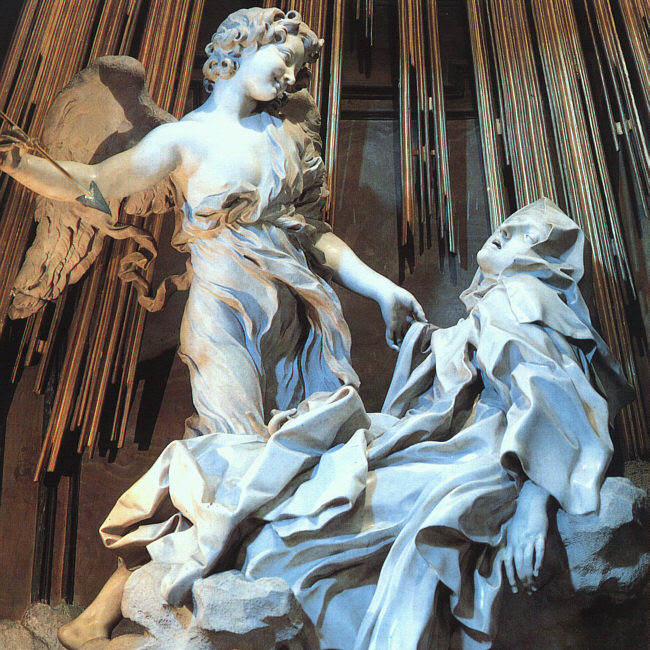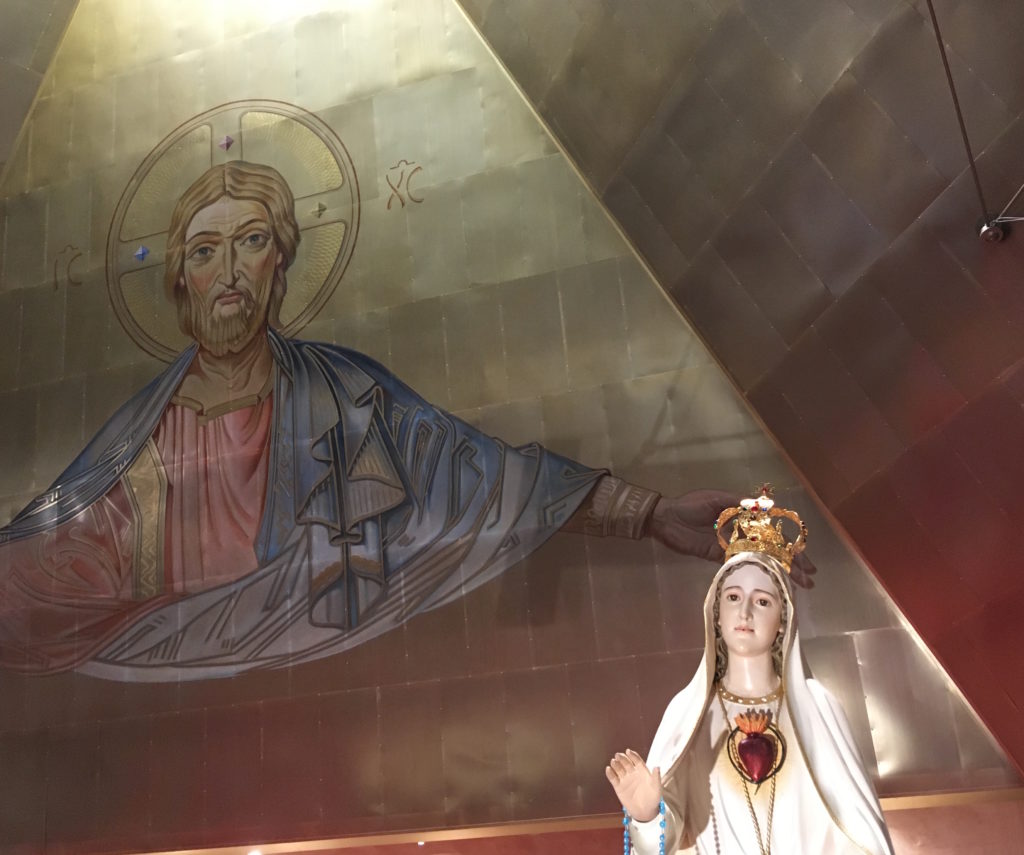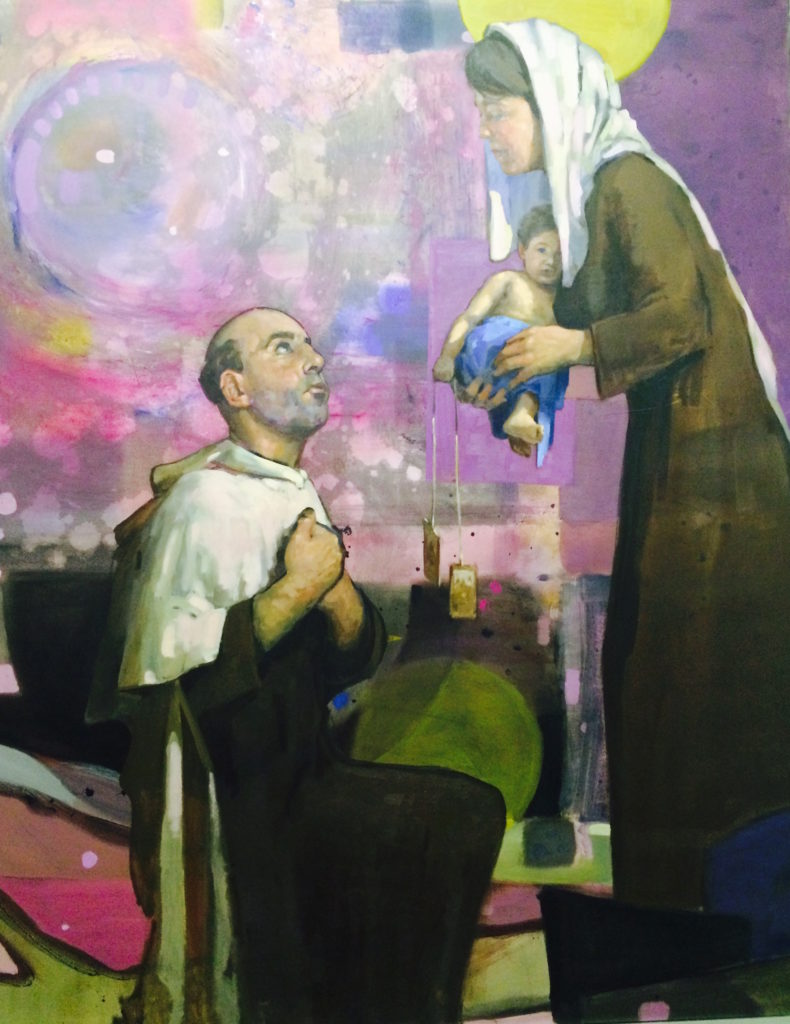
(REPOST FROM August 2017)
NOTE: If you would like to get a virtual tour of the sepulcre where St. Teresa’s heart is kept, click on this Alba de Tormes link
St. Teresa was so profoundly the temple of the Holy Spirit. She was so filled with the zeal and spirit of Saint Elijah, that God’s love in her heart was confirmed through the Transverberation. The Transverberation is a special grace that is typical of souls whom God has exalted and elevated to the sixth mansion predominantly, but slightly overlapping with the seventh mansion. St. Teresa is famous to have received this grace.
She wasn’t the only one, of course. St. John of the Cross probably experienced it, but he just didn’t say it, which was very typical of St. John. He knew and expressed the grace so well that it’s likely that he also received the same grace. St. Thérese received something very similar to the Transverberation in the Choir of her convent. Blessed Mariam of Jesus Crucified, we know for a fact, received that grace, as did the most wonderful and illustrious St. Father Pio, in the confessional.
These special graces are insignias; they are signs of what God has done in a person’s soul already, but is manifesting in a special and specific way. In St. Teresa’s case, the Transverberation was such a profoundly spiritual experience that it had a physical effect, as the doctors found out when examining the mortal remains of St Teresa’s actual, physical heart. This is kind of perplexing and paradoxical because when we speak of the heart like the Sacred Heart of Jesus or when we speak of God dwelling in our “heart” we don’t necessarily mean specifically, the physical organ of the heart, but the center of the person’s soul. Nevertheless, St. Teresa’s physical heart did receive the effect of that spiritual manifestation.
These graces are accidentals in the lives of the saints. St. Teresa wasn’t declared or made a saint because she had these spiritual experiences. She was declared and made a saint because she had the infused virtues of what unites us to God: Faith, Hope, and Love! That’s what made her a saint! This is what is necessary. This is what is essential to be united with the splendor of God’s truth.
These infused virtues are most beautiful. They bestow the transfiguring love of God’s eternal life, enlarge our lives and enable us to share in His holiness. It was Saint Teresa’s cooperation with the grace of God’s inspirations, in obedience to His divine will that allowed the kingdom of God to make in her, His temple. That’s what made her a saint! Her ‘Yes,’ her fiat, her agape, her ‘Be it done unto me according to thy will. Here I am I was born for you! What do you want of me? I am yours!!’
That fundamental disposition is what led to St. Teresa’s transformation, and as the book of Hebrews says, ‘Without faith, it is impossible to please God.’ In other words, without faith we’re not open to friendship with God. Our Lord says in so many ways in the gospels that it’s not enough to be religious. Being religious isn’t what saves us; it is obedience to His will and uniting our hearts to His, according to how He wants us to love – not in the way we want, in conformity to our comforts.
Jesus expresses this truth in the gospels when He says, ‘Not everybody who says Lord, Lord, shall enter the kingdom of heaven, but those who do the will of my heavenly Father.’ In other words, we can be very religious, have statues and pictures, and even pray rosaries, but if we’re not living what we believe by aligning our lives with the love of God and how He asks us to love in our daily circumstance, then according to God, our talk is cheap. We need to live what we believe. When we say, ‘Yes,’ when we live what we believe and make that sacrifice, that death to self in order to be lifted up in Him – then that transformation can begin. Otherwise, our faith is superficial and only on the surface.
The saints show us what is beyond the surface, the depths of our own identity, the depths of who we are each called to be in His divine mercy. The saints reveal to us the glory of God’s love for everyone, for it is the saints who have the courage to say, ‘Yes’ to the maximum. The saints had the courage to let themselves be loved to the full. That’s all God wants of us – to let ourselves be loved to the full. This is a gift and the greatest gift we could possibly have – more than our physical life, more than our jobs, more than our own family, more than all the physical necessities of our daily life, or of what makes life pleasurable. Our greatest gift is faith! Without faith we have Nada! Nada! Nada! — Nothing!!
Without faith, even the beauty of the most magnificent churches passes away, for that beauty is only meant to point us to Him. It is meant to point us to Him in friendship. It is meant to inspire this ‘Yes Lord, live in me. Be it done unto me according to your will.’ Salvation began with the ‘Yes’ of Mary. God’s mission of the Messiah, Emmanuel, began to embrace the world with the simple ‘Yes’ of a woman so humble, with Mary just saying ‘Yes’ to Him.
Amidst this invitation and this beauty of what we are called to and who we are called to be in His love, there will be a battle. We hear in scriptures, in the reading of St. Paul to the Ephesians, that there is a battle; there is a spiritual world behind the material scenes of the world. Our world is the stage where we will each decide whether we will be a winner or a loser; whether we will be victorious by saying ‘Yes’ to God’s love and allowing that to transform our lives; whether we are able to share in the only love that overcomes death and sin that cleanses us from within. And this decision will determine our ultimate destiny.
In order to be faithful to this love, we need to put on God’s armor in the midst of the battle. We need to be protected; we need to fight to defend this dignity. We need to fight a spiritual warfare against the world, the flesh, and the devil. Our primary General is Mary, who crushes the head of the serpent, who is full of grace and conceived without sin. It is she who can help us to be united to the victory of her Son.
As we prepare the stage of our lives, we ask Jesus for the grace to grow more and more in His love, in holiness and the perfection of charity. We ask that God’s love be brought to maturity in the whole of our identity and personality. In St. Teresa – this illustrious human being , in all of her warmth, intelligence, and humor of her personality – shines a love that is larger than life and out of this world. She points us to God’s love, as God draws us to Himself. Through the intercession of St. Teresa, may we receive the grace to be faithful to the end that our faith may be set fully on fire. Saint Teresa, pray for us.
(SOURCE: Alba de Tormes, Spain Pilgrimage)
‘



